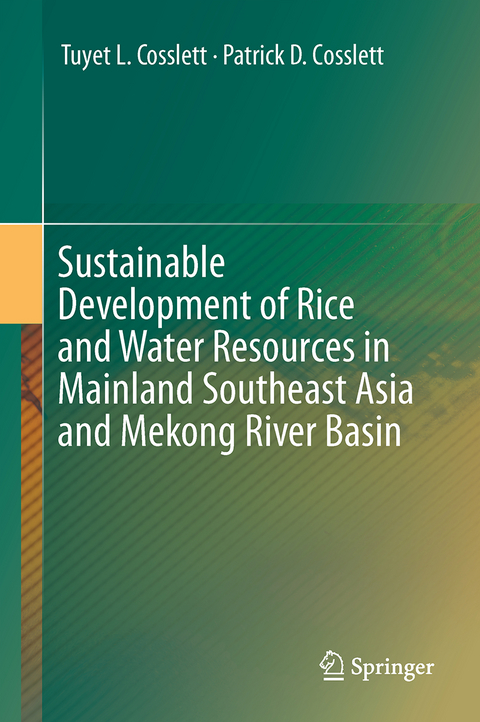
Sustainable Development of Rice and Water Resources in Mainland Southeast Asia and Mekong River Basin
Springer Verlag, Singapore
978-981-10-5612-3 (ISBN)
Ms. Tuyet L. Cosslett VA, USA Mr. Patrick D. Cosslett VA, USA
Introduction.- 1. The Setting of Cambodia, Laos, Thailand, and Vietnam.- 1.1 Topography.- 1.1.1 Cambodia.- 1.1.2 Laos.- 1.1.3 Thailand.- 1.1.4 Vietnam.- 1.2 Population.- 1.2.1 Cambodia.- 1.2.2 Laos.- 1.2.3 Thailand.- 1.2.4 Vietnam.- 1.3 Workforce.- 1.3.1 Cambodia.- 1.3.2 Laos.- 1.3.3 Thailand.- 1.3.4 Vietnam.- 1.4 Economy.- 1.4.1 Cambodia.- 1.4.2 Laos.- 1.4.3 Thailand.- 1.4.4 Vietnam.- References.- 2. Rice Cultivation, Production, and Consumption in Cambodia, Laos, Thailand, and Vietnam.- 2.1 Rice Cultivation.- 2.1.1 Cambodia.- 2.1.2 Laos.- 2.1.3 Thailand.- 2.1.4 Vietnam.- 2.2 Rice Production.- 2.2.1 Cambodia.- 2.2.2 Laos.- 2.2.3 Thailand.- 2.2.4 Vietnam.- 2.3 Rice Consumption.- 2.3.1 Cambodia.- 2.3.2 Laos.- 2.3.3 Thailand.- 2.3.4 Vietnam.- 2.4 Conclusion.- References.- 3. Rice trade of Cambodia, Laos, Thailand, and Vietnam.- 3.1 Background of rice exports of Thailand, Vietnam, and Cambodia 1855-1999.- 3.1.1 Thailand.- 3.1.2 Vietnam.- 3.1.3 Cambodia.- 3.2 Policies of rice export of the four countries in the new millennium.- 3.2.1 Thailand.- 3.2.2 Vietnam.- 3.2.3 Cambodia.- 3.2.4 Laos.- 3.3 Performance of rice exports of Thailand, Vietnam, and Cambodia in 2000-2014.- 3.3.1 Rice export relative to world rice export.- 3.3.2 Rice export relative to milled rice production.- 3.4 Rice trade of the four countries in 2000-2014.- 3.4.1 Rice trade balance.- 3.4.2 Rice trade competition.- 3.5 Rice across border trade.- 3.5.1 Cambodia border trade with Vietnam and Thailand.- 3.5.2 Laos border trade with Vietnam, Thailand, and China.- 3.5.3 Thailand border trade with Burma and China.- 3.5.4 Vietnam border trade with Cambodia, Laos, and China.- 3.6 Rice regional cooperation proposals.- 3.6.1 Council on Rice Trade Cooperation Proposal in 2002.- 3.6.2 Organization of Rice Exporting Countries Proposal in 2008.- 3.6.3 Southeast Asia Rice Association Proposal in 2012.- 3.6.4 ASEAN Rice Federationin 2012.- 3.6.5 Failures of Rice Cartel Proposals.- 3.7 Conclusion.- References.- 4. Lower Mekong Basin: Rice production, Climate change, ENSO, Chinese Mekong Dams.- 4.1 The Mekong River.- 4.1.1 The Lancang Jiang.- 4.1.2 The Lower Mekong River.- 4.2 Lower Mekong Basin setting.- 4.2.1 Topography.- 4.2.2 Population.- 4.2.3 Economy.- 4.3 Agricultural land, paddy land, and paddy rice production.- 4.3.1 Agricultural land and farming.- 4.3.2 Paddy rice production.- 4.4 Climate change, floods and droughts, and El Nino Southern Oscillation (ENSO).- 4.4.1 Assessment of climate change.- 4.4.2 Impact of floods and droughts in the Lower Mekong Basin.- 4.4.3 El Nino and La Nina of the ENSO cycle (2001-2016).- 4.5 Chinese Mekong mainstream dams.- 4.5.1 Mekong mainstream dams in China.- 4.5.2 Impacts of Chinese dams in the Lower Mekong Basin.- 4.6 Conclusion.- References.- 5. Mekong Regional Cooperation for Water Resources and Rice Security.- 5.1 Mekong River Commission Structure and Programs.- 5.1.1 MRC structure.- 5.1.2 MRC Basin development strategy.- 5.1.3 MRC Agriculture and irrigation programs.- 5.1.4 MRC Rules of Procedure for water utilization and diversion.- 5.2 MRC Review of Lower Mekong Mainstream Dams.- 5.2.1 Proposed mainstream dams in Lower Mekong Basin.- 5.2.2 MRC review of Xayaburi dam project.- 5.2.3 MRC review of Don Sahong dam project.- 5.2.4 Studies on impacts of the Lower Mekong River mainstream dams.- 5.2.5 Assessment of the Mekong River Commission.- 5.3 Mekong Regional Cooperation Organizations.- 5.3.1 Greater Mekong Subregion.- 5.3.2 Lower Mekong Initiative.- 5.3.3 Mekong-Japan Summit.- 5.3.4 Lancang-Mekong Cooperation Mechanism.- 5.4 China Role in Mekong Regional Cooperation.- 5.5 Conclusion.- References.- Conclusion.
| Erscheinungsdatum | 14.10.2017 |
|---|---|
| Zusatzinfo | 7 Illustrations, color; X, 148 p. 7 illus. in color. |
| Verlagsort | Singapore |
| Sprache | englisch |
| Maße | 155 x 235 mm |
| Themenwelt | Naturwissenschaften ► Biologie ► Ökologie / Naturschutz |
| Naturwissenschaften ► Geowissenschaften ► Hydrologie / Ozeanografie | |
| Sozialwissenschaften ► Politik / Verwaltung | |
| Sozialwissenschaften ► Soziologie ► Spezielle Soziologien | |
| Technik ► Lebensmitteltechnologie | |
| Wirtschaft ► Betriebswirtschaft / Management | |
| Weitere Fachgebiete ► Land- / Forstwirtschaft / Fischerei | |
| Schlagworte | climate change • Don Sahong dam • food security • Greater Mekong Subregion • Lancang-Mekong Cooperation Mechanism • Lower Mekong Basin • Lower Mekong Initiative • Mekong cooperation frameworks • Mekong-Japan Summit • Mekong mainstream dams • Mekong River Commission • Mekong river water • Paddy land • regional cooperation • Rice Consumption • Rice cultivation • rice production • Rice Trade • Water security • Xayaburi dam |
| ISBN-10 | 981-10-5612-9 / 9811056129 |
| ISBN-13 | 978-981-10-5612-3 / 9789811056123 |
| Zustand | Neuware |
| Haben Sie eine Frage zum Produkt? |
aus dem Bereich


